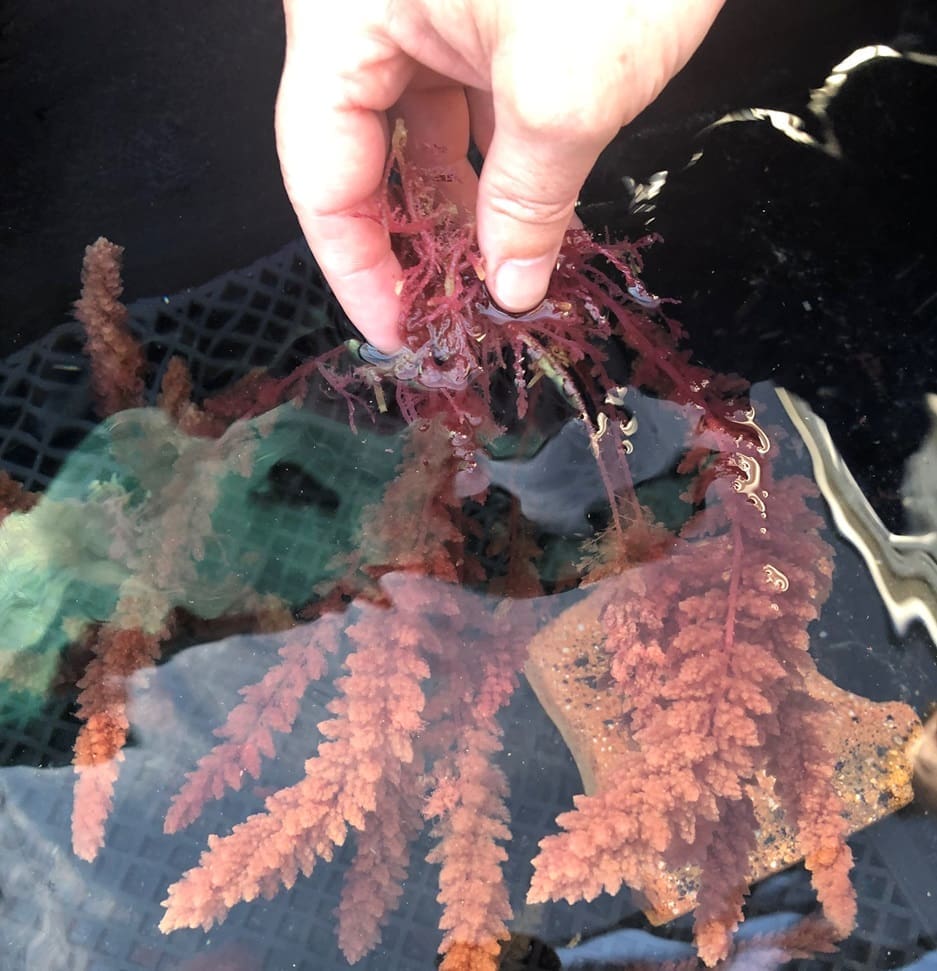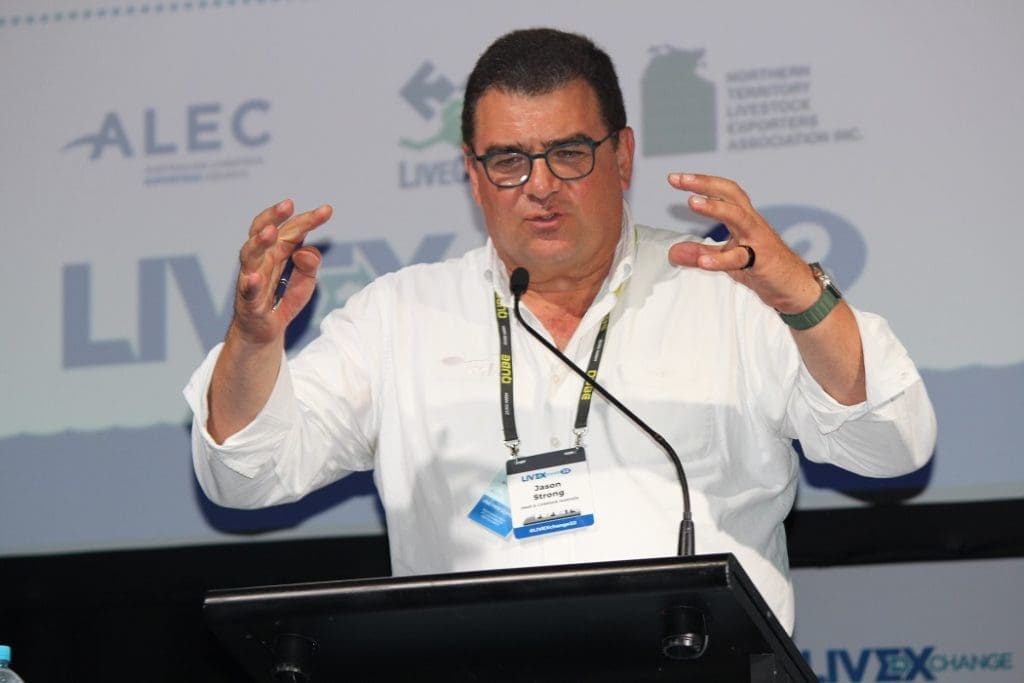A FEW years ago, few people had heard of Asparagopsis.
But today, this red seaweed is becoming a well-known innovation that is showing significant promise for its ability to reduce methane emissions for the livestock sector.

Compounds in red asparagopsis seaweed have been found to reduce methane emissions from livestock by at least 80 percent
When fed to cattle in a feedlot situation as part of a total mixed ration (less than 1pc of dry matter intake), Asparagopsis has been shown repeatedly to reduce methane emissions by 80 percent or more.
On the back of significant research over a decade, Asparagopsis is now being made available from commercial partners via FutureFeed, which was formed in 2020 to commercialise the technology that was developed by CSIRO, together with MLA and James Cook University.
FutureFeed issues licenses to seaweed growers and processors around the world, enabling supply of Asparagopsis to the livestock market under an agreed quality control framework.
We are already seeing Asparagopsis being grown and sold commercially and there are also early-mover products testing the consumer market, including the Grill’d burger chain’s ‘game changer’ burger.
At the same time, because this technology is relatively new to our industry, there is ongoing work needed to understand the details of adopting the technology in our industry, including the costs, benefits and opportunities.
There is a large program of investment underway to identify new Asparagopsis based products as well as the opportunities, barriers, and pathways to adoption and commercialisation.
Research putting ‘other pieces in the puzzle’
These projects are occurring via investments from MLA and our investment partners, separately through the Commonwealth Government’s Methane Emissions Reduction in Livestock (MERiL) program, and through commercial entities.
Each time a new research project concludes it places another piece into the puzzle, helping us understand the various products that might incorporate Asparagopsis and also helps us to understand further questions that need to be answered.
One of the most recent – and longest – research projects, involving AA Co and Waygu cattle (see today’s separate story) is doing exactly that. The 275-day study was the first of its kind in Wagyu steers. It is supporting previous data that showed the technology reduces emissions, while having no impact on attributes of the beef evaluated by a trained sensory panel.
“In this case, there were lighter carcase weights compared to a control group of similar cattle not receiving the Asparagopsis product. This was in contrast with all previous work in feedlot cattle,” FutureFeed Chief Scientist, Dr Rob Kinley, said.
“The anomaly is considered a result of reduced feed intake. The contrast in this specific feeding system highlights the need for more pieces in the puzzle to be filled, with continued work with variable feeding regimes and breeds.”
The diet consisted of a lower grain content than previous studies with feedlot cattle. This contributed to a tempered methane reduction response.
That said, the study was the longest ever diet exposure with the seaweed and there was no effect on meat quality or loss of methane reduction effectiveness, which is great news. This is a never-before-seen offering of persistent long-term methane reduction. In other words, the effect did not ‘wear off’.
Recently MLA co-funded a study involving Asparagopsis oil (known as P.PSH.1351) which demonstrated methane mitigation in the range of (54.5 to 95pc+) with no effect on animal or food safety over an 80-day feeding period.
Later this year, a seminal feedlot cattle study funded in the MERiL program will publish the results of a productivity trial for 150 steers on a higher grain diet, building more information in the space.
Based on emerging international research, there are already indications of where to focus future research to ensure we create productivity gains while also reducing methane reductions.
Remember, this technology is new. Like so many activities in our industry, we will tackle these questions with innovation and research to make sure that we are bringing together the positive environmental outcomes with positive productivity outcomes.
Each scientific trial is a step in the journey on the innovation pathway for these products, and it’s great to see organisations both within industry and the scientific community working hard to understand this space.
This research was critical to provide transparent data to Australian producers as the knowledge will help refine future approaches to feeding dried Asparagopsis and Asparagopsis oil-based products for industry and commercialisers.
There has also been some discussion in the media recently about the safety of Asparagopsis.
In multiple studies, researchers have not detected any residual bromoform, the methane inhibitor produced in the seaweed, in any part of the beef cattle or beef products including the meat, fat, kidneys, livers, offal and faecal matter.
There is significant potential for this technology for the industry and MLA looks forward to working with the industry and other partners to see its long-term success.
 Author Jason Strong is managing director of Meat & Livestock Australia
Author Jason Strong is managing director of Meat & Livestock Australia



Don’t you just love the ruminant physiology.
Able to reject woke sunny skies/happy faces (used to be blue skies) research hypotheses in a single trial.
Even if we pretend that methane is a real problem for the case of the argument, I am having a bit of trouble getting past the North Sydney/Canberra junta justification for anti-methane research that “reducing methane from the rumen would make the system more efficient and cattle would grow faster”. ( & therefore a good use of your levy funds.)
And yet those pesky AA Wagyus, only reduced methane by 30%, and only at the cost of a 9.38% REDUCTION in liveweight gain. (2 decimal points – clearly great science.)
Let us hope they never achieve a 70% methane reduction.
Not that we poor simple would in the bush would know, but a 10% LWG reduction in a feedlot seems a tad expensive exercise in feeling good.
Perhaps Jason and the Asparagonauts at MLA could divert the industry portion of the R&D levy into researching the argument that methane from ruminants is a long-term nil-sum cycle, and the industry could try standing on its hind legs and tell the preachers to leave our cows alone.
Well said Tom! In the accompanying article AA Co’s David Harris says “We want to be part of the climate change solution”. It would really help my understanding if David, the MLA and the assorted agenda driven zealots /fellow travelers in this game could spell out, in testable detail, “what the climate change problem” actually is? Coming from a lifetime of research perspectives gained in the sheep and cattle industries I certainly have not seen any objective evidence of an impending ‘climate Armageddon’. Perhaps someone feasting on the “settled science” could provide the hard data that shows me how wrong they think I am?
Well said Bill!
Massive thickening occurring. Graziers unable to maintain their productivity levels for the sake of the “Green Gods”. I recall an article of yours Circa 2002 where “change in carbon stocks in the grazed woodlands of Queensland is equivalent in magnitude to c. 25% of the published (1999) total estimated national net emissions. ”
“Data from 57 permanent monitoring sites were used to document the growth in woody vegetation and estimate the carbon sink in 27 M ha of eucalypt woodlands (savannas), contained within c. 60 M ha of grazed woodlands in Queensland. The study sites were shown to be representative of the environment and structure of the eucalypt woodlands sites of 0.5T C/ha/yr., similar to values estimated elsewhere in world savannas. Published root: shoot ratios were used to infer C flux in woody root systems on these sites. This results in an estimated sink in above and below-ground biomass of 18 Mt C/yr. over the eucalypt woodlands studied, and potentially up to 35 Mt C/yr. if extended to all grazed woodlands in Queensland. It is suggested that introduction of livestock grazing and altered fire regimes have triggered the change in tree-grass dominance in these woodlands.”